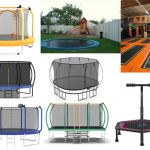
- trampolining-vs-running
- benefits-of-trampolining
- running-exercise-benefits
- trampolining-health-effects
- Trampoline-Zone-exercise
Comparing the Impact on Cardiovascular Health
When considering whether trampolining is better than running, it's important to analyze how each affects cardiovascular health. Running is a well-known aerobic exercise that raises heart rate effectively, improving endurance and overall heart health. Many runners appreciate the rhythmic, consistent nature of jogging or sprinting for cardiovascular conditioning.
However, trampolining offers a unique cardiovascular workout through its low-impact bouncing motions, which engage multiple muscle groups while minimizing joint strain. Studies have shown that trampolining can provide heart rate elevation comparable to moderate running, making it an excellent alternative for those seeking cardio benefits without high joint stress.
Users at Trampoline Zone have reported improved stamina and heart health while enjoying a fun, dynamic exercise experience that running sometimes lacks.
Joint Impact and Injury Risk
Running is a high-impact activity that places significant stress on knees, ankles, and hips. Over time, this impact can lead to injuries like shin splints, runner's knee, or joint degeneration. For people with existing joint issues or arthritis, running may not be the safest choice.
Conversely, trampolining provides a low-impact exercise option. The trampoline mat absorbs much of the shock, reducing stress on the joints while still offering a full-body workout. This makes trampolining a preferred option for individuals recovering from injury or those looking to protect their joints while staying active.
Many users on Trampoline Zone find trampolining a safer yet effective alternative to traditional high-impact exercises like running.
Muscle Engagement and Toning
Running primarily targets lower-body muscles, including calves, hamstrings, and quadriceps, with some engagement of the core for balance. It is a reliable way to build leg strength and endurance.
Trampolining, however, engages a wider range of muscle groups. Besides working the legs, the constant balance adjustments activate core muscles intensely. Arms and back muscles also get involved as the body maintains stability during bouncing routines. This comprehensive muscle engagement can lead to improved overall toning and strength.
Many athletes at Trampoline Zone notice increased core strength and better posture after consistent trampolining sessions, benefits that running alone might not provide.
Mental Health Benefits and Enjoyment
The repetitive and often solitary nature of running can be mentally therapeutic for many, promoting stress relief and mindfulness. However, it can also become monotonous.
Trampolining introduces a playful and joyful element to exercise, often described as fun rather than work. This can increase motivation and consistency. Moreover, the rhythmic bouncing and sensory input stimulate the brain positively, potentially enhancing mood and reducing anxiety.
Trampoline Zone users frequently share stories of how trampolining helped improve their mental well-being by making exercise feel like a joyful activity rather than a chore.
Calorie Burning and Weight Management
Both trampolining and running burn calories effectively, aiding in weight management. Running, depending on intensity, typically burns more calories per minute due to its higher exertion level.
However, trampolining can be sustained longer by many due to its low-impact nature, and it also combines cardio with muscle toning, which can elevate metabolic rate. This makes it a highly efficient workout for sustained weight loss when combined with a healthy diet.
Users at Trampoline Zone have found success in weight management by integrating trampolining into their routines, enjoying longer, more frequent sessions than traditional running.
Practical Considerations and Accessibility
Running is highly accessible—requiring only a good pair of shoes and open space. It can be done virtually anywhere, making it convenient.
Trampolining requires equipment, either a home trampoline or access to a facility. However, small, portable trampolines have made this activity more accessible for home workouts. Additionally, trampolining can be safer in harsh weather or urban environments.
For those interested in starting or upgrading trampolining equipment, Trampoline Zone offers a wide range of trampolines and accessories tailored to various needs and skill levels.







 Dunham's Sports3.0 (332 reviews)
Dunham's Sports3.0 (332 reviews) Sky Zone Trampoline Park4.0 (2153 reviews)
Sky Zone Trampoline Park4.0 (2153 reviews) Pell City Civic Center4.0 (277 reviews)
Pell City Civic Center4.0 (277 reviews) Kids Empire San Antonio Park North4.0 (710 reviews)
Kids Empire San Antonio Park North4.0 (710 reviews) Hop's Bounce House4.0 (175 reviews)
Hop's Bounce House4.0 (175 reviews) Citrine Sky Park4.0 (18 reviews)
Citrine Sky Park4.0 (18 reviews) Are Trampoline Parks Safe for Kids? Essential Guide for U.S. Parents
Are Trampoline Parks Safe for Kids? Essential Guide for U.S. Parents How Often Should You Replace Trampoline Springs? Tips for Proper Maintenance
How Often Should You Replace Trampoline Springs? Tips for Proper Maintenance How Much Is a Trampoline? A Detailed Guide to Trampoline Costs and Buying Tips
How Much Is a Trampoline? A Detailed Guide to Trampoline Costs and Buying Tips Bounce Techniques for Stronger Legs: Effective Exercises and Tips
Bounce Techniques for Stronger Legs: Effective Exercises and Tips Essential Music Gear for Trampoline Dance: Complete Guide
Essential Music Gear for Trampoline Dance: Complete Guide Fun STEM Experiments Using Trampolines to Spark Curiosity and Learning
Fun STEM Experiments Using Trampolines to Spark Curiosity and Learning